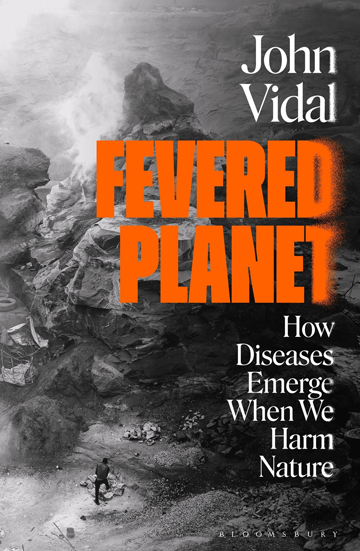
Book review: Fevered Planet, by John Vidal

By Jeremy Williams

“Throughout history,” writes John Vidal, “advances in civilisation – agriculture, domestication, urbanisation and globalisation – have all been accompanied by increasing disease risk. But never before has the human population been so large, so hyper-connected and living at such high densities. We are now approaching a storm of spiralling disease risk.”
That’s the argument made at the start of Vidal’s extraordinary book, Fevered Planet: How Diseases Emerge When We Harm Nature. Looking back at history, it appears that the earliest humans had little experience of illness. They were plagued by plenty of other things, from ticks to toothache, but small and mobile communities that didn’t interact widely with others left little room for germs to spread. Each step in history has brought new risks. Domesticating animals increases the opportunity for animal pathogens to hop from one species to another. Lots of people in a dense urban space makes it more likely that the new disease will spread.
Understanding the basics of how new diseases have emerged in the past, it isn’t hard to see how our modern world has ramped up the risks. Factory farms have too many animals in close proximity, practically inviting viral experimentation. Air travel allows new diseases to spread rapidly around the world, as we all saw in real-time with COVID-19. Despite the advances of modern medicine, “it is likely that there are more infectious diseases in the world today than at any other time in history.”
The book’s particular interest is the environmental aspect of this. Vidal spent decades as the environment editor at the Guardian. In that time he reported from over a hundred countries, and again and again he saw connections between disease and ecology.
Sometimes the connection is straightforward: wildfire smoke causes respiratory illness. Sometimes it’s much more complicated. Fires in Indonesia led fruit bats to flee the area and relocate to orchards in Malaysia. Here they dropped half-eaten fruit into the pig pens where they were roosting. The pigs got sick, the illness hopped to humans, and 109 people died from the novel paramyxovirus. Over a million pigs were killed and the Malaysian pork industry was devastated.
These more tangled stories often take scientists years to work out, as anyone still pondering the exact origins of COVID-19 will know. The book investigates many of the familiar themes that turn up in stories of disease emergence: lab escapes, wet markets, and bushmeat traditions. Among many other things, it also covers airborne threats from the polluted dust of the Aral Sea, invasive insects, anthrax thawing from ancient ice, and the many forms of zoonotic diseases that emerge from disrupted ecosystems.
A cheerful book it is not, but it’s not a hopeless one either. Vidal makes a convincing case that the patterns of environmental destruction that lead to new diseases are the same ones that drive the climate crisis and the collapse of biodiversity. Disease is a symptom of a broken relationship with nature, one strand in the unravelling of the earth’s life support systems. That means that as we act on climate change, the burden of disease will also be reduced. Along with all the many reasons for doing such things, restoring degraded land and reconnecting with nature will also reduce the risk of future pandemics.
With his decades of on-the-ground reporting from so many places in the world, so often places of misery and destruction, John Vidal was the only person who could have written Fevered Planet. It’s the product of a unique career – and also something of a last word. Vidal passed away in October, but if we heed the message of the book, his insights could leave a life-saving legacy.
First published in The Earthbound Report.
Categories: Uncategorized, Health, environment, Reviews, book review, Anthropocene